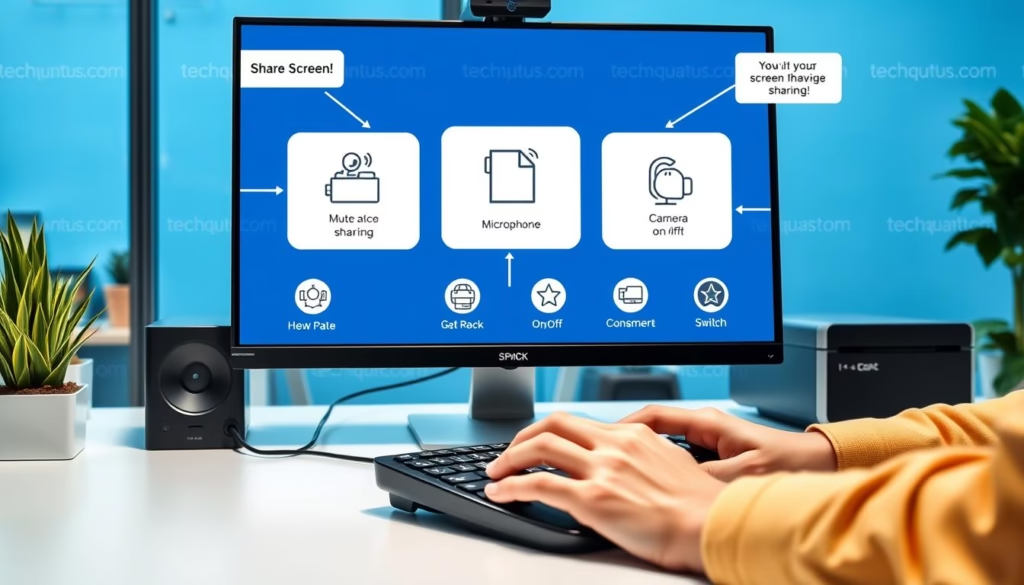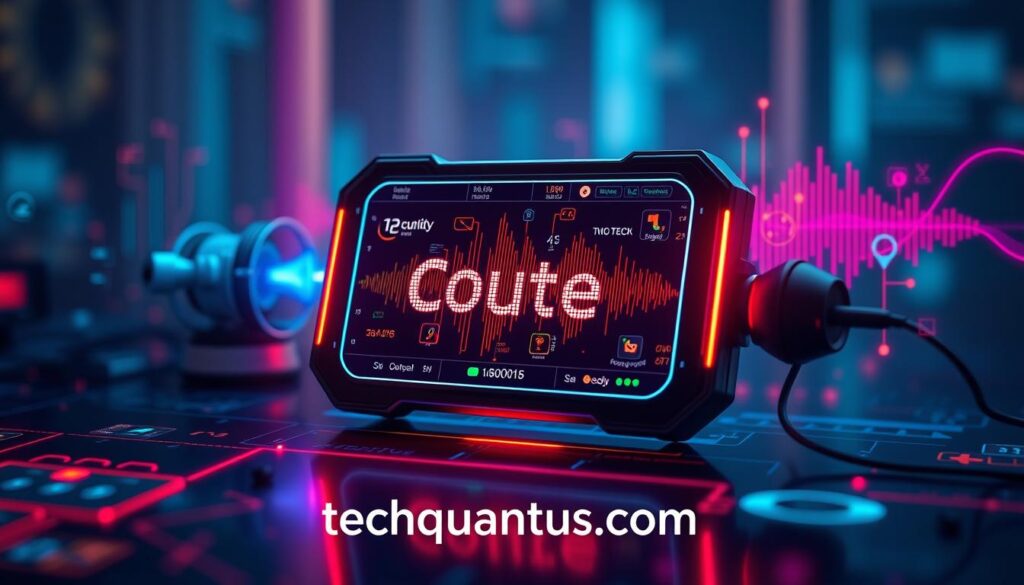The world of smart device technology is changing fast. Voice-activated apps are leading this change. They let users control their devices and access features just by speaking.
The global market for digital voice assistants is growing fast. It’s expected to hit 8.4 billion units by 2024. This shows how much people want easy voice-activated experiences.
In this guide, we’ll cover the basics of voice-activated tech. We’ll also show you how to make voice-controlled apps step by step. Plus, we’ll share tips on making these apps work well for users.
Whether you’re an experienced developer or new to voice-activated tech, this article will help. You’ll learn how to make top-notch voice-activated apps that meet today’s consumer needs.
Key Takeaways
- Voice-activated apps use speech recognition and natural language processing for easy control of IoT devices.
- The global market for digital voice assistants is expected to reach 8.4 billion units by 2024, showing the growing demand for voice-controlled tech.
- To develop voice-activated apps, you need to understand speech recognition engines, natural language processing, and how devices communicate.
- Using cloud-based voice processing solutions can improve your app’s performance and scalability.
- Testing and optimizing your app is key to ensure it works well, recognizes speech accurately, and controls devices reliably.
Understanding Voice Assistant Technology Fundamentals
Voice assistant technology is changing how we use digital devices. It uses automatic speech recognition (ASR) and natural language processing (NLP). These are the basics that let voice-activated apps and virtual assistants get what we say.
Key Components of Voice Recognition Systems
Voice recognition systems need linguistic and acoustic models to understand speech. They use AI to get better over time, thanks to lots of spoken language data. The main parts of voice recognition are:
- Speech recognition engines that turn audio into text
- Natural language processing libraries for understanding spoken words
- Device communication protocols that make voice commands work
Basic Architecture of Voice-Activated Apps
Voice-activated apps start by capturing audio. Then, they process it with speech recognition and NLP. Finally, they act on connected devices. This includes:
- Audio capture from the user’s microphone
- Speech-to-text conversion using ASR technology
- Natural language understanding to figure out what the user wants
- Device integration and command execution
Role of Natural Language Processing
Natural language processing (NLP) is key in voice assistant tech. It makes talking to AI systems smooth. NLP and NLU help understand the meaning and intent of spoken commands. This makes voice-activated apps give accurate and personal answers.
Getting Started with Voice-Activated Tech Development
The rise of voice assistant apps and AI virtual assistants has changed how we use technology. Voice-activated devices are everywhere, making it crucial to develop new voice-controlled apps. To start, there are important things to think about.
First, define what your app will do and who it’s for. What problems will it solve? Who will use it? Knowing this helps you decide what features your app needs. This includes voice recognition, smart home control, and more.
Then, pick the right technologies for your app. You might use Conversational AI, machine learning, and IoT for better data sharing. These tools help make your app smart and responsive to users.
When developing, focus on making your app easy to use. Use natural language processing and personalization to make it user-friendly. This ensures your app works well with how people speak and their preferences.
The success of voice-activated tech comes from blending new features with user needs. By using the latest in voice recognition and AI, you can make apps that improve daily life. They make tasks easier and more accessible.
“The future of voice-activated technology looks promising, with continued integration into various aspects of daily life and the potential for further advancements and expansions.”

Choosing the Right Speech Recognition Engine
The voice technology market is growing fast. Businesses need to pick the best speech recognition engine for their needs. Google, Amazon, and Microsoft offer different solutions for various budgets and needs. It’s important to know what each platform can do to make a good choice.
Google Speech-to-Text Solutions
Google Speech-to-Text is a cloud-based service that uses machine learning. It can transcribe audio from many sources. It supports over 120 languages and works in real-time, making it great for businesses needing lots of language support.
Amazon Transcribe Features
Amazon Transcribe is scalable and affordable, part of the AWS ecosystem. It can identify languages automatically and support custom vocabularies. It also offers advanced features like sentiment analysis, making it good for businesses with specific needs.
Azure AI Speech Capabilities
Microsoft’s Azure AI Speech has many tools for speech recognition. It lets you create custom language models and supports real-time translation. It’s great for businesses that want high accuracy and flexibility in their voice applications.
When choosing a speech recognition engine, consider pricing, accuracy, language support, and integration. The right choice can improve your business’s efficiency, customer experience, and competitiveness. By using the strengths of these platforms, you can fully benefit from voice technology.
| Platform | Key Features | Pricing Model | Best Fit |
|---|---|---|---|
| Google Speech-to-Text |
| Pay-per-use | Businesses requiring extensive language support and low-latency performance |
| Amazon Transcribe |
| Subscription-based | Organizations with specific terminology or multilingual requirements, already using AWS services |
| Azure AI Speech |
| Subscription-based | Enterprises prioritizing accuracy, customization, and flexibility to build tailored voice applications |
Implementing Speech-to-Text Conversion
Voice-activated technology is changing how we use our devices. It’s key to turn speech into text well for apps to work smoothly. This means catching what the user says and sending it to a service for text.
Big names like Google, Amazon, and Microsoft have APIs for this. Google’s Speech-to-Text uses smart learning to get text right, in many languages. Amazon Transcribe is great for businesses, with tools like custom vocab and batch transcription.
Adding NLP to speech-to-text lets apps understand and act on what users say. This tech is key for smart assistants and smart homes. It makes them work better.
“Speech recognition software has evolved significantly over the years – starting from recognizing numbers in the 1950s to recognizing up to 20,000 words in the 1980s.”
Voice tech is getting better fast. It’s used in marketing to find out what people like and want. In healthcare, it helps by making notes during talks into patient records.
Developers who get good at speech-to-text can make apps that are easy to use. As more people want to talk to their devices, keeping up with this tech is important.

Natural Language Processing Integration
As voice-activated technology grows, Natural Language Processing (NLP) is key. NLP lets these systems understand human speech well. This opens up a new world of easy user experiences.
Tokenization and Parsing Methods
At the heart of NLP is tokenization. It breaks down speech into words or “tokens.” Then, part-of-speech tagging and parsing figure out the sentence’s structure. These steps help the system grasp language’s subtleties, leading to better semantic analysis.
Semantic Analysis Techniques
Semantic analysis is crucial for understanding user commands. Voice-activated apps use machine learning and knowledge bases to guess the user’s intent. This lets the system answer more accurately and naturally, making the user experience better.
Intent Recognition Strategies
The top goal of NLP is to recognize user intent well. Advanced models, using deep and reinforcement learning, link spoken commands to actions. This skill is vital for voice systems to meet user needs, making them more useful.
The rise of voice-activated tech makes NLP even more important. By combining tokenization, semantic analysis, and intent recognition, developers can make apps that really get what we say. This leads to a more natural and fun user experience.
| Key NLP Techniques | Applications | Potential Benefits |
|---|---|---|
| Tokenization and Parsing | Breaking down speech into words and understanding sentence structure | Enables more accurate interpretation of user commands |
| Semantic Analysis | Inferring meaning and intent behind user utterances | Allows for more contextual and relevant responses |
| Intent Recognition | Mapping user input to specific actions within the app | Enhances the overall functionality and usability of voice-activated systems |
Device Communication and Control Protocols
IoT device communication and smart home protocols are key for voice-activated tech. They let us control devices and systems easily. This includes finding devices, pairing them, sending commands, and making them work.
Protocols like Wi-Fi, Bluetooth, and Zigbee help devices talk to each other. They let voice assistants find and control devices. This makes voice commands work smoothly.
When a voice command is given, the device acts on it. It then tells the user if it worked or not. This makes voice tech a great way to manage smart homes and automate tasks.
| Protocol | Advantages | Use Cases |
|---|---|---|
| Wi-Fi |
|
|
| Bluetooth |
|
|
| Zigbee |
|
|
Knowing about IoT device communication and smart home protocols helps developers. They can make voice-activated apps that work well with many devices. This gives users a smart and responsive experience.
“The future of voice technology is not just about improving speech recognition, but about integrating it seamlessly with the physical world and creating truly intelligent, context-aware interactions.”
Cloud-Based Voice Processing Solutions
Artificial intelligence (AI) and machine learning (ML) have made voice recognition better. They can now understand natural language and work in noisy places. Cloud-based systems use powerful servers and smart algorithms for efficient voice control.
Cloud-based systems have big advantages over old systems. They can get better over time with new updates and lots of data. They also grow easily to meet more users and devices, making voice control smooth.
Server Architecture Setup
Building a strong server setup is key for cloud voice systems. It needs a system that can handle lots of audio data fast and well. Cloud-native tech like containers and serverless computing make it easier to grow and manage these services.
Data Management and Storage
Keeping data safe and reliable is crucial for cloud voice systems. This means secure storage for voice data and results. It’s important to follow data privacy rules and keep user info safe to build trust.
Scalability Considerations
As more people use cloud-based voice processing, it must grow with them. Systems should adjust to more users without slowing down. Cloud features like autoscaling and load balancing help keep things running smoothly.
“Warehouse mis-picks reduced by as much as 86% with voice-enabled apps, and ROI realized in less time than traditional voice apps take to deploy.”
Security and Privacy Implementation
As more people use voice-activated tech, like smart home devices and personal assistants, keeping data safe is key. These systems are super convenient but also bring risks. We need to protect user data and keep trust.
One big worry is keeping voice data and commands safe. Some research shows how easy it is to hide voice commands in noise or sounds we can’t hear. This could let bad actors control devices without permission. Also, voice biometrics, used for access, can be tricked by fake voices.
To fix these issues, app makers need to use strong encryption and multi-factor authentication. They should also have clear privacy policies. This helps users feel secure and in control of their data.
Another problem is when devices misunderstand voice commands. This can lead to things happening by accident, like sharing audio without wanting to. Testing and quality checks are vital to make sure voice tech works right.
New threats, like “skill-squatting” attacks, show we need better security and education. It’s important for tech companies, security experts, and governments to work together. This way, we can face new challenges together.
| Statistic | Insight |
|---|---|
| Approximately 61% of smart home device owners in the United States use voice commands through virtual assistants to control their smart home devices. | The widespread adoption of voice-activated technologies in the smart home industry highlights the importance of ensuring robust security and privacy measures to protect users. |
| Capital One has developed a third-party voice app for Amazon Alexa to enable customers to perform personal banking tasks. | The integration of voice-activated technology in sensitive domains, such as banking, necessitates stringent security protocols to safeguard user data and prevent unauthorized access. |
| NHS Digital in the UK partnered with Amazon to allow patients to access health information through the Alexa assistant. | The use of voice-activated assistants in the healthcare sector underscores the criticality of privacy protection and data governance to ensure the confidentiality of sensitive medical information. |
As the voice assistant security and privacy in voice tech landscapes evolve, we must stay alert and work together. By focusing on security and privacy, we can enjoy the benefits of voice tech safely. This way, we protect our trust and well-being.
Testing and Quality Assurance
Creating voice-activated apps needs careful testing and quality checks. This ensures the app works well, understands speech, and performs actions smoothly. Testing covers performance, user experience, and fixing bugs. By improving the app based on feedback, developers can make it better and lead in voice tech.
Performance Testing Methods
Testing how well voice apps work is key. It checks if the app can handle lots of users, different networks, and various speech. Tools help test how fast, accurate, and scalable the app is.
User Experience Validation
It’s important for voice apps to be easy to use. Testing with different users finds problems and checks how well the app understands speech. Making changes based on feedback helps improve the app for everyone.
Bug Tracking and Resolution
Fixing bugs quickly keeps voice apps working well. Good bug tracking and fixing processes help teams solve problems fast. This keeps the app reliable and enjoyable for users.
By focusing on testing, user experience, and bug fixing, developers make voice apps better. Using the latest testing tools and practices helps them stay ahead in the voice tech world.
| Testing Approach | Key Objectives | Recommended Tools |
|---|---|---|
| Performance Testing | – Evaluating system responsiveness under high user loads – Measuring accuracy and latency in speech recognition – Assessing scalability and reliability | – Load testing tools (e.g., JMeter, Gatling) – Automated speech recognition testing frameworks |
| User Experience Validation | – Identifying pain points in the voice interface – Assessing natural language understanding – Evaluating overall usability and intuitiveness | – User testing platforms (e.g., UserTesting, Hotjar) – Cognitive walkthrough techniques |
| Bug Tracking and Resolution | – Comprehensive issue reporting and tracking – Efficient collaboration and debugging workflows – Proactive monitoring and data-driven insights | – Bug tracking tools (e.g., Jira, Trello) – Continuous integration and deployment platforms |
By taking a complete approach to quality, developers can make voice apps better. This leads to more people using voice tech in many areas.
Best Practices for Voice App Optimization
The voice recognition market is growing fast, expected to hit $26 billion by 2024. Making your voice-activated apps better is key for businesses. Here are the top tips for voice app optimization:
- Prioritize User-Centric Design: Put the user first when making your app. Learn what they need and how they like to interact. Make sure your voice prompts and app flow match their natural way of speaking.
- Streamline Voice Interactions: Use clear, short, and direct voice prompts. This makes it easy for users to navigate your app. Keep responses quick and avoid asking for the same thing over and over.
- Implement Robust Error Handling: Be ready for mistakes and misunderstandings. Offer clear error messages and easy ways to fix problems.
- Enable Continuous Learning: Use machine learning to get better at understanding speech and user intent. Always look at user feedback and data to improve your app.
- Embrace Accessibility and Inclusivity: Make your app work for people in different languages and with various abilities. Add features like text-to-speech and speech-to-text to reach more users.
- Maintain and Update Consistently: Keep an eye on user feedback, new trends, and tech updates. Fix bugs, add new features, and integrate with other services to keep your app fresh and useful.
Follow these best practices to make your voice app better. This way, you’ll give users a smooth and focused experience that keeps up with the latest in voice tech.
| Statistic | Value |
|---|---|
| Voice recognition market size | $26 billion by 2024 |
| Monthly global voice searches | 1 billion |
| Daily voice search usage in the US | 50% of the population |
| Worldwide mobile voice search usage | 27% of internet users |
| Consumer preference for voice search | 71% prefer voice over typing |
| Smart speaker ownership in the US | 35% of consumers |
“Optimizing for voice search is not just about targeting the right keywords – it’s about understanding the user’s intent and delivering a seamless, intuitive experience.”
Conclusion
The future of voice-activated tech is looking bright. Advances in AI, natural language processing, and speech synthesis are making our interactions smoother. We’re seeing big changes in how we use smart devices at home and in our cars.
More people are using voice assistants in different areas, like healthcare and education. Businesses are using voice chatbots to improve customer service. Healthcare is also changing with voice technology, making care more accessible.
Looking to the future, we’ll see even better voice technology. It will understand us better, work with more devices, and support many languages. As tech improves, voice assistants will become a big part of our lives, making our digital world easier to use.
FAQ
What are the key components of voice recognition systems?
Voice recognition systems have a few key parts. These include speech recognition engines, natural language processing libraries, and device communication protocols.
What is the basic architecture of voice-activated apps?
Voice-activated apps work by capturing audio. They then process it using speech recognition and NLP algorithms. Finally, they take action on connected devices.
What are the steps to develop a voice-activated app?
To make a voice-activated app, start by setting its goals and who it’s for. Then, pick the right tech like Conversational AI and machine learning. Also, consider cloud computing and IoT.
What are the popular speech recognition engines available?
There are many speech recognition engines out there. Google Speech-to-Text, Amazon Transcribe, and Azure AI Speech are popular. They use machine learning for different languages and audio types.
How does speech-to-text conversion work in voice-activated apps?
Speech-to-text works by capturing audio from the user. It sends this audio to a voice recognition service. The service then returns the text, which is processed further with NLP libraries.
What role does natural language processing play in voice-activated apps?
NLP helps understand what the user wants. It breaks down the text into parts and analyzes its meaning. This way, it connects the user’s intent to actions in the app.
What are the common protocols used for device communication in voice-activated apps?
Devices talk to each other using Wi-Fi, Bluetooth, and Zigbee. These protocols help find and pair devices. They also send and execute commands.
What are the advantages of cloud-based voice processing solutions?
Cloud-based solutions use powerful servers and advanced algorithms. They make voice control efficient. This means better accuracy, scalability, and easier updates.
How can security and privacy be implemented in voice-activated apps?
To keep user data safe, use strong encryption for data transmission. Also, store voice commands and preferences securely. And, make sure users can authenticate themselves.
What are the best practices for testing and quality assurance of voice-activated apps?
For quality, test voice integration and functionality well. Also, check how the app performs and if it’s easy to use. Use bug tracking and solve issues quickly.
Source Links
- Building a Voice Recognition App for Controlling IoT Devices | Krasamo – https://www.krasamo.com/voice-recognition-app/
- How to Design Voice-Controlled Smart Devices for Blind People – https://makeitfable.com/article/how-to-design-voice-controlled-smart-devices-for-blind-people/
- Understanding the Basics of Voice AI: A Comprehensive Guide – https://www.linkedin.com/pulse/understanding-basics-voice-ai-comprehensive-guide-scot-westwater
- How Do Voice Assistants Work? The Basics Explained – Miquido Blog – https://www.miquido.com/blog/what-are-voice-assistants/
- Get started with voice access – https://support.microsoft.com/en-us/topic/get-started-with-voice-access-bd2aa2dc-46c2-486c-93ae-3d75f7d053a4
- Voice Recognition App Development: A Complete Guide – https://chisw.com/blog/voice-recognition-app-development/
- Voice-Activated Devices: Revolutionizing Accessibility & Tech | OrCam – https://www.orcam.com/en-us/blog/voice-activated-devices?srsltid=AfmBOop4qp-mwwenjiKu5tM8F0l6dRPWcXEcQd6vTviSFMf2m59Ds0Zg
- 5 Best Speech Recognition Software – https://www.altexsoft.com/blog/speech-recognition/
- Explore the 7 best speech-to-text (STT) engines of 2024 – https://telnyx.com/resources/best-speech-to-text-engine
- Top 12 Things That You Need to Know About Voice Technology – https://www.moontechnolabs.com/blog/voice-technology/
- What is Speech to Text? – Speech to Text Explained – AWS – https://aws.amazon.com/what-is/speech-to-text/
- What is Speech To Text? | IBM – https://www.ibm.com/think/topics/speech-to-text
- Natural Language Processing (NLP): The science behind chatbots and voice assistants – https://www.oneadvanced.com/news-and-opinion/natural-language-processing-nlp-the-science-behind-chatbots-and-voice-assistants/
- How NLP Improves Multilingual Text-to-Speech & Voice Assistants – https://tech-stack.com/blog/how-nlp-improves-multilingual-text-to-speech-voice-assistants/
- Unlock the Power of NLP for Voice-Activated Systems – https://dig8italx.com/nlp-voice-systems/
- From Touch to Sound: How Voice Technology Is Changing the IoT Landscape – https://intellias.com/from-touch-to-sound-how-voice-technology-is-changing-the-iot-landscape/
- Voice-Activated Technology: Transforming the Way We Interact with Devices – https://www.linkedin.com/pulse/voice-activated-technology-transforming-way-we-interact-rahul-p-dfnxc
- Advancements in Voice Recognition Technology: Impact on Transcription – https://bluenotary.us/voice-recognition-technology-enhancements-innovations/
- Speech Recognition & Voice Automation Software Technology | Ivanti – https://www.ivanti.com/use-cases/add-voice-to-my-applications
- Voice Assistants: Use Cases & Examples for Business [2024] – https://masterofcode.com/blog/voice-assistants-use-cases-examples-for-business
- The Security of Voice-Activated Technology – Dionach – https://www.dionach.com/the-security-of-voice-activated-technology/
- Voice-Activated Home Security: Controlling Your System with Voice Commands – StaySafe.org – https://staysafe.org/home-safety/security-voice-activated/
- Voice Technology and QA Testing | Cooperative.io – https://www.cooperative.io/insights/voice-technology-qa-testing
- How To Test Smart Voice Assistant Technology? – https://blog.qasource.com/es/smart-voice-assistant-technology-how-to-test-it
- The Future of Audio Quality Testing: AI in QA Technologies – https://www.testdevlab.com/blog/the-future-of-audio-quality-testing-artificial-intelligence-in-qa-technologies
- Future Proofing Your App with Voice Search Optimization Strategies – ShyftUp – https://www.shyftup.com/blog/future-proofing-your-app-with-voice-search-optimization-strategies/
- Voice Search Optimization: 6 Tips to Improve Your Results – https://www.semrush.com/blog/voice-search-optimization/
- Mastering Voice Search Optimization To Elevate User Experience – Simply Be Found – https://simplybefound.com/mastering-voice-search-optimization-to-elevate-user-experience/
- Voice-Activated Technology: Revolutionizing How We Connect – https://www.orcam.com/en-us/blog/voice-activated-technology?srsltid=AfmBOopwhTbi-1EkIh_6NsaBifdYUWmLyeKNm1skDLZWGu5b2pxtnRxb
- Voice Activated Technology The Future at Our Fingertips – https://www.zrix.com/blog/Voice-Activated-Technology-The-Future-at-Our-Fingertips
Related posts:
 How to Use AI Chatbots for Customer Support Automation
How to Use AI Chatbots for Customer Support Automation
 Data Privacy Regulations: What IT Professionals Need to Know in 2024
Data Privacy Regulations: What IT Professionals Need to Know in 2024
 The Global Race for Quantum Computing Dominance: Who’s Leading?
The Global Race for Quantum Computing Dominance: Who’s Leading?
 How to Create High-Quality Synthetic Media Using AI
How to Create High-Quality Synthetic Media Using AI
 How to Integrate 5G and IoT for Smart Cities Development
How to Integrate 5G and IoT for Smart Cities Development
 How to Set Up a Virtual Firewall for Your Cloud Infrastructur
How to Set Up a Virtual Firewall for Your Cloud Infrastructur









